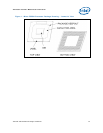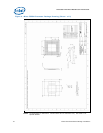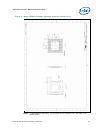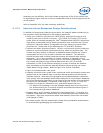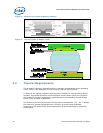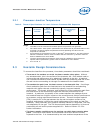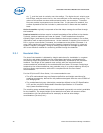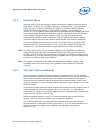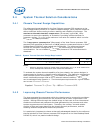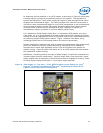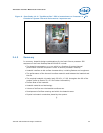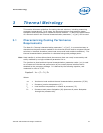
Processor Thermal/Mechanical Information
20 Thermal and Mechanical Design Guidelines
air, T
A
, and the local air velocity over the surface. The higher the air velocity over
the surface, and the cooler the air, the more efficient is the resulting cooling. The
nature of the airflow can also enhance heat transfer via convection. Turbulent
flow can provide improvement over laminar flow. In the case of a heatsink, the
surface exposed to the flow includes in particular the fin faces and the heatsink
base.
Active heatsinks typically incorporate a fan that helps manage the airflow through
the heatsink.
Passive heatsink solutions require in-depth knowledge of the airflow in the chassis.
Typically, passive heatsinks see lower air speed. These heatsinks are therefore
typically larger (and heavier) than active heatsinks due to the increase in fin surface
required to meet a required performance. As the heatsink fin density (the number of
fins in a given cross-section) increases, the resistance to the airflow increases: it is
more likely that the air travels around the heatsink instead of through it, unless air
bypass is carefully managed. Using air-ducting techniques to manage bypass area
can be an effective method for controlling airflow through the heatsink.
2.3.1 Heatsink Size
The size of the heatsink is dictated by height restrictions for installation in a system
and by the real estate available on the motherboard and other considerations for
component height and placement in the area potentially impacted by the processor
heatsink. The height of the heatsink must comply with the requirements and
recommendations published for the motherboard form factor of interest. Designing a
heatsink to the recommendations may preclude using it in system adhering strictly to
the form factor requirements, while still in compliance with the form factor
documentation.
For the ATX/microATX form factor, it is recommended to use:
• The ATX motherboard keep-out footprint definition and height restrictions for
enabling components, defined for the platforms designed with the micro-FCBGA of
this design guide.
• The motherboard primary side height constraints defined in the ATX Specification
V2.2 and the microATX Motherboard Interface Specification V1.2 found at
http://www.formfactors.org/.
The resulting space available above the motherboard is generally not entirely available
for the heatsink. The target height of the heatsink must take into account airflow
considerations (for fan performance for example) as well as other design
considerations (air duct, etc.).




